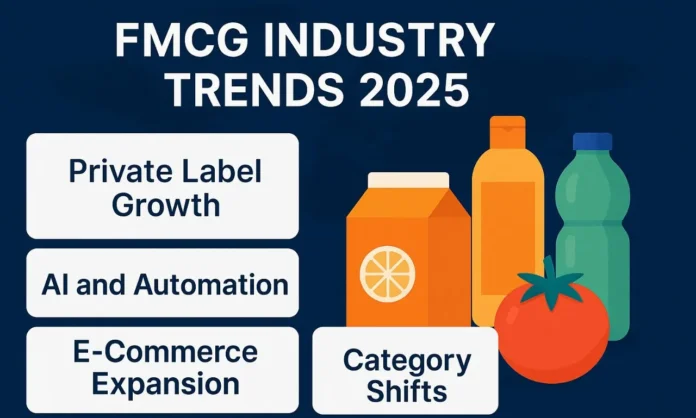In 2025, FMCG industry is experiencing massive change. Changes in shopper behaviour, increasing global supply and step up of private label are rewriting the way that fast-moving consumer goods is produced, priced and promoted. In this week’s category spotlight, we examine key FMCG industry trends 2025 and what they mean for supermarket buyers, manufacturers, and retailers.
Strongholds on Private Labels Continue
In the increase of volume and value, private label has remained successful in various geographical regions. The discounters and the mainstream and these firms are furthered investing in in house brand and ship both haughty and incoming line. The changes are to be seen as permanent and in most markets, we now see the share of private labels in staple products maintaining a share in excess of 40 %.

Premiumization can be also seen. The consumers are embracing superior quality exclusive label assortments in health, organic and ready-meal categories. Retailers now also manufacture sub-brands within their super-brands to bring different values and quality levels. This benefit of tiering enables enhanced shelf segmentation and more average price per unit.
Improvements in local manufacturing, logistics infrastructure, and sourcing strategies also spur growth in the private label in Asia and Latin America. With sourcing increasingly regionalized, increased numbers of supermarkets are vertically integrating the development of own-label products and hence are able to have more control over margins and maintaining the supply chain.
Value-Based-Purchasing and Promotional Stress
The pressure of inflation is distracting shoppers to look at value-based decisions. Food inflation in some portions of Europe and Asia has been cooling, but the overall sensitivity in basket is high. Consequently, the FMCG producers are experiencing a new wave of pressure in offering multi-packs, price-marked packs and aggressive promotion techniques.
Price perception is increasingly becoming a subject of empowerment with the use of loyalty card programs. Retailers are moving offers beyond apps, behind membership programs and with data, they can target specific offers that appeal to income category, location or even basket activity. At the same time, we can see a visible shift to more frequent, smaller, but less massive promotional packages: flash sales, time-sensitive packages, store-related limited-time offers.
This disintegration in promotion approach is making retailers and brand clash. Other supermarkets are shortening promotional windows or putting more rigid ROI targets on the use of co-funded campaigns. The brands that cannot show volume uplift with the use of digital tools are losing this promotional space to either the private label or their tech-savvy competitors.
Digital and E-commerce Fast-forwarding
Internet FMCG growth is settling down after the pandemic but is way higher than before 2020. Logistics E-commerce is being enhanced in many supermarkets, including automated fulfilment centres and more effective data-based targeting.
Direct-to-consumer (DTC) models by major FMCG players have seen mixed results, but partnerships with grocery platforms are increasing. The subscription of categories, such as baby products, personal care and household cleaning, is on the rise.
Since click-and-collect is more profitable than home delivery, and hybrids fulfilment networks assist regional grocers in speed and cost-saving. This is redefining the shelf game planning, where brands are now prepping against two different in-store and digital display game plans.
In the context of FMCG industry trends 2025, digital shelf optimization is a top priority. To compete online, brands are investing on content syndication, ratings/reviews and digital packaging. Real-time product visibility, stock accuracy and dynamic pricing are also being increasingly used AI.
Sustainability as a Business Force
Commercial viability is associated with environmental performance. Customers and regulators are now pressuring retailers as well as FMCG companies to get rid of wastage and minimize emissions and enhance traceability.
The packaging that can be recycled, material based on plants as well as the labeling concerning carbon foot print is all affecting each other positively and in high speed in 2025. The companies that adhere to these trends have a higher chance of receiving a preference placement in retail and marketplace algorithms.
Notably, sustainability is one of the cost subjects too. There is pressure on brands to be greener without increasing rates. With increased plastic ban by governments and green tax incentives, FMCG players have to invest but keep their products affordable.
The suppliers are also being given tighter sustainability scorecards by retailers. Recent developments show that water consumption, on-farm emissions, ethical sourcing have been redefined as important metrics to be used in procurement decision. These scores are slowly being posted on shelves or online by supermarkets which then has competitive advantage to suppliers who comply.
Format Innovation and Category Shifts
There is format disruption in a number of FMCG categories. Ambient and frozen meals are also becoming popular since they are cheap and have long shelf life. Single-serve and snack-sized are meanwhile being changed to accommodate off the morrow demand.
There is also a change of categories of beverages. Cutting edge SKUs including functional drinks, low sugar and non-alcoholic options are gaining higher sale frequencies than traditional SKUs. Solid and refillable formats are stimulating brand interaction with the younger population in the field of personal care.
Innovation is also been witnessed in the pet care segment. The aisle is being transformed by subscription-based delivery of individual pet food blends, functional health-benefitting pet treats, and environmentally friendly packaging.
These format changes reflect broader FMCG industry trends 2025, including health focus, portability, and packaging innovation. Retailers are relying on predictive analytics to find out what formats are most effective by location and demographics.
AI and Retail Technology Combination
Suppliers and retailers in FMCG are finding it easier to use AI in order to manage price, assortment and inventory. There is the application of predictive analytics to improve out-of-stock and promote timing.
Smart shelves, on-demand merchandising and patterns in shopper behavior are shifting gears into use in prime markets. In the case of FMCG manufacturers, it is no more a matter of choice to go along with the tech-enabled retailer.
Also, product development is increasingly influenced by AI. Ingredient simulation, trend forecasting and even afforded an AI-generated flavor profile are becoming part of the mainstream FMCG tool kit.
Voice-assisted ordering, augmented reality try-ons (for cosmetics), and machine learning-based demand prediction are pushing tech deeper into customer journeys. In the case of supermarkets, it would be to create a connection between offline and online retail experiences in a non-complicated manner.
Finding the balance between globalization and Localisation
The supply chains are turning into becoming more regional. The need to be resilient, reduce the cost of transport, and have a faster turnaround is compelling FMCG brands to come up with regional hubs.
Meanwhile, there is an increase in product localization. Supermarkets are requesting local taste versions, cultural efficacy in packages, and even regional offers.
Sourcing locally is also touted as a marketing angle by retailers particularly in the fresh, dairy and bakery goods. Labels such as “locally made” or “regionally sourced” are improving shopper trust and spend.
The balance between global scale and local agility is one of the defining FMCG industry trends 2025. To be successful now they must also be flexible in their production, agile in their marketing, and work more closely with the retailers.
Labor, Regulation and Price Prospects
One of the pressure points is labor. Retailers and FMCG players are both automating manualistic processes and paying attention to training employees in digital tools. Bottlenecks in the life of workers in the field of logistics and warehouse management remain due to shortages of workers.
The regulatory shifts of labeling, disclosure of nutrition as well as advertisement to children are growing. FMCG brands are re-examining the workflow of packaging and positioning products as well as compliance.
In the meantime, commodity volatility is seen particularly in oil, sugar and grains, which requires repricing on a regular basis. Hedging in inflation-linked contracts is becoming the norm in the FMCG procurements department.
Conclusion
FMCG industry trends 2025 show a sector in transition. Supermarkets and suppliers have to act upon economic changes, the repromotion of values by the shoppers and emerging technologies. The speed of change is on the rise price of change nowadays, and includes the private label development, sustainable innovation and AI-`driven strategies.
The winning participants this year will be those who will be able to create value, be dynamic, are responsive to digital data and can create good supply chains. These trends will spell the difference in success after 2025 to every actor in the fast-moving consumer goods industry.



